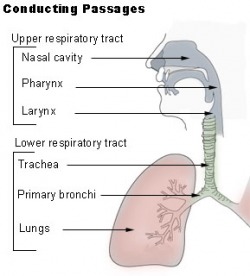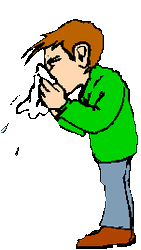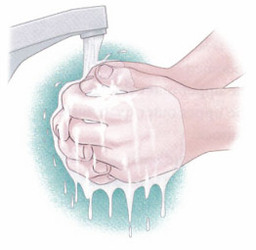Virology
Picornaviridae
A picornavirus is a virus belonging to the family Picornaviridae.The name is derived from pico meaning small (typically, 18-30 nm), and RNA referring to the ribonucleic acid genome, so "picornavirus" literally means small RNA virus. Picornaviruses are separated into 12 distinct genera and include many important pathogens of humans and animals. The diseases they cause are varied, ranging from acute "common-cold"-like illnesses, to poliomyelitis, to chronic infections in livestock.
Some of the genera: - Aphtovirus
- Cardiovirus
- Enterovirus
- Heptovirus
- Rhinovirus
Some of the genera: - Aphtovirus
- Cardiovirus
- Enterovirus
- Heptovirus
- Rhinovirus
Morphology
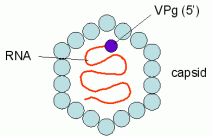
· Virions (naked)
Virions are virus particles: they are the inert carriers of the genome, and are assembled inside cells, from virus-specified components: they do not grow, and do not form by division.
· Nucelocapsid isometric
· Incomplete or empty (does not contain genome) capsids common
Virions are virus particles: they are the inert carriers of the genome, and are assembled inside cells, from virus-specified components: they do not grow, and do not form by division.
· Nucelocapsid isometric
· Incomplete or empty (does not contain genome) capsids common
Genome
· One linear (+) RNA
· Genome is infectious
· There is a long (600-1200 base) untranslated region at the 5' end and a shorter 3' untranslated region (50-100 bases)
· Both ends of the genome are modified, the 5' end by a covalently attached small, basic protein, the 3' end by polyadenylation (polyadenylic acid sequences are not genetically coded)
· One linear (+) RNA
· Genome is infectious
· There is a long (600-1200 base) untranslated region at the 5' end and a shorter 3' untranslated region (50-100 bases)
· Both ends of the genome are modified, the 5' end by a covalently attached small, basic protein, the 3' end by polyadenylation (polyadenylic acid sequences are not genetically coded)
Viral entry
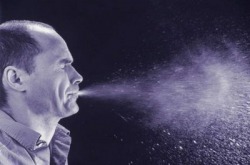
1. Droplet transmission
2. Direct skin contact
3. Sexual transmission
4. Oral transmission
5. Direct inoculation
6. Trans-placental
2. Direct skin contact
3. Sexual transmission
4. Oral transmission
5. Direct inoculation
6. Trans-placental
Pathogenesis
1. Nasal epithelium
2. Short incubation (2-3 days)
3. Replicate best at 33 degree celsius
4. Endogenous interferons help
Interferons are protein molecules released by host cells to non-specifically inhibit the spread of viral infection. Interferons are particularly effective against viruses with RNA genomes and are often crucial in reducing their effects.
5. Locally synthesized IgA but titer decline with time
6. Serum IgG persists for years
7. Over 100 rhinoviruses
1. Nasal epithelium
2. Short incubation (2-3 days)
3. Replicate best at 33 degree celsius
4. Endogenous interferons help
Interferons are protein molecules released by host cells to non-specifically inhibit the spread of viral infection. Interferons are particularly effective against viruses with RNA genomes and are often crucial in reducing their effects.
5. Locally synthesized IgA but titer decline with time
6. Serum IgG persists for years
7. Over 100 rhinoviruses
Symptoms
When someone becomes infected with a rhinovirus, he or she will experience what is commonly known as the common cold. The symptoms usually begin 2 to 3 days after infection. The symptoms of infection with this type of virus often include:
· Mucus buildup in your nose
· Difficulty breathing through your nose
· Swelling of your sinuses
· Sneezing
· Sore throat
· Cough
· Headache.
With a rhinovirus infection, fever is usually slight, but can climb to 38.89 degree Celsius in infants and young children.
When someone becomes infected with a rhinovirus, he or she will experience what is commonly known as the common cold. The symptoms usually begin 2 to 3 days after infection. The symptoms of infection with this type of virus often include:
· Mucus buildup in your nose
· Difficulty breathing through your nose
· Swelling of your sinuses
· Sneezing
· Sore throat
· Cough
· Headache.
With a rhinovirus infection, fever is usually slight, but can climb to 38.89 degree Celsius in infants and young children.
Laboratory diagnosis

Nasal washings are the best specimens and should be collected early in the disease when maximal titres of virus is excreted.
1. Virus isolation
2. Direct detection of rhinovirus antigen - an ELISA has been developed for the detection of rhinovirus antigen in nasal washings.
3. Serology - virus neutralization tests remain the best method. ELISAs have been described.
1. Virus isolation
2. Direct detection of rhinovirus antigen - an ELISA has been developed for the detection of rhinovirus antigen in nasal washings.
3. Serology - virus neutralization tests remain the best method. ELISAs have been described.
Control
· Wash hands
· Do not touch your eyes or nose
· Sneeze into a tissue
· Dispose the tissue in a rubbish bin
· Stay at home if you caught a cold
· Wash hands
· Do not touch your eyes or nose
· Sneeze into a tissue
· Dispose the tissue in a rubbish bin
· Stay at home if you caught a cold
